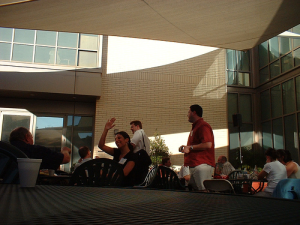 In the previous post in this series, I thought through three concepts underlying a network of neighborhoods and arrived at provisional definitions of each concept:
In the previous post in this series, I thought through three concepts underlying a network of neighborhoods and arrived at provisional definitions of each concept:
- Neighborhood: a love-formed relational space, usually composed of persons in physical proximity
- Value of Ordinary Life: the relative worth given to ordinary life by the Creator, Lord, and Deliverer of all, Jesus Christ
- Interconnected Web: the real, spiritual connection present among members of the Body of Christ by virtue of their necessary connection to the Head
Two practical questions remain.
- How might these concepts be embodied in the life of the Church?
- How might the church instruct, equip, and train members to embody these in ordinary life?
In this post, I think through the question of embodying the idea of neighborhoods.
Embodying a Neighborhood
Loving as we Disperse for Service
Humans naturally form neighborhoods; they seem to be a part of who we are. Therefore, the church brings, not the idea of neighborhoods, but rather a richer understanding of the motivation behind neighborhoods and of the love that forms them.
Natural loves, whether friendly, sensuous, or self-sacrificing, are reflections of God’s love. We all know, if we are honest, that the Church may or may not be better at love, for our practice of love varies by maturity, commitment, and obedience. What the Church does have is an experiential knowledge of God’s love, unknown to those who do not trust Christ. We carry this knowledge with us as we disperse for service and, as we submit our ways to Christ’s rule, this knowledge shapes our expressions of love.
God created humanity as a reflection of his rule and relational nature by giving us dominion and by making us male and female (Gen 1:26-28). Our inherent relational nature reflects and draws us toward God. The fall (Gen 3) corrupted, but did not remove, these reflections.
Yearning for the fulfillment of our relational nature (fully complete only in Christ) draws us to one another in order to form families, neighborhoods, cities, and cultures. All humans have this yearning, even if it has been distorted beyond recognition by injury or disappointment. Family, friends, co-workers, and acquaintances yearn for the experience of neighborhood that gives the taste of God’s love that both satisfies and increases our hunger for him and his people.
As we disperse for service, carrying with us the knowledge of fulfilled relational nature and ultimate love, let us decide to behave according to our knowledge. Let us decide to love the other and let that love form neighborhoods wherever we are.
Sharing as we Gather for Worship
As the church gathers for regular corporate worship [1], the members of the body bring with them experiences from their various neighborhoods. These experiences ought to be brought forth and shared to the glory of God.
Stories. Sharing stories of ordinary life as part of corporate worship is, quite honestly, a bit counterintuitive. We have so formalized and structured our worship gatherings that who we are in daily life is all but irrelevant. A bit of courage and creativity will be required to make space for stories with no overt God-connection.
Even more, we need a shift from worship gathering as separate from life to worship gathering as part of life. Those on the podium and those in the pew likely have a difficult paradigm shift to undergo.
Such story sharing probably already occurs in small groups and informal fellowship gatherings: this is good. But incorporating neighborhood stories into the corporate gathering frames the stories as acts of worship and better communicates the value placed on ordinary life by the gathered community.
In addition to stories of ordinary life, some will share stories as offerings of praise, recognizing specific things God has done in their neighborhoods. These stories, offered as acts of worship by individual persons, stimulate a worship response in the gathered persons.
Other stories will express needs from the various neighborhoods: needs brought before our very great God as offerings of worship that acknowledge his power and concern. Such stories also stimulate a worship response, not only in the gathering, but also in ordinary life, as members of the gathered church offer their skills and capacities in response to shared needs.
Connection. The stories that we bring are shared in physical space: they are easy to recognize, if difficult to incorporate. The person-to-person connections that we bring back to the gathering take place in a more ethereal space.
This idea is difficult to put into words, but we have experienced it. For example, we hear stories of a family member’s co-worker and when that co-worker has her first child, we rejoice, even though we’ve never met. These heart-to-heart connections are real and, when they are brought back to the gathering and nurtured, they are strengthened. When these connections are believer-to-believer, the unity of Christ’s church is strengthened. This strengthened unity, spread person-to-person throughout our various neighborhoods, will make a possitive and powerful impression on the world.
By this all people will know that you are my disciples, if you have love for one another.
John 13:35 ESV
How can our gatherings prepare us for these two tasks?
- loving as we disperse for service
- sharing as we gather for worship
[1] There are other important reasons for gathering, but worship gatherings focus on God’s worth and this is the specific type of gathering I intend to explore here. I am also considering here how this might work in an institutional church. Other forms of church may consider other applications of this concept.

